Lessons from 10 years of recruitment and game design teams management
If you found yourself on this article, you are probably trying, or considering, becoming a game designer, working on your favorite AAA games, being the creative force behind experiences millions of players will enjoy around the world.
Congratulations! You decided to embark on a fabulous adventure. After more than 10 years in the industry designing games like Assassin’s Creed Origins, Beyond Good & Evil 2 or Gods & Monsters, I can’t stop loving this job and be amazed by what so many of us are creating. To me, this is the best job in the world, and I hope you will be able to say the same in 10 years from now.
But there is the grim reality: the amount of applicants for each open game designer position is enormous. We are talking easily about a 50 to 1 ratio depending on where you are located. Many countries now have a vast array of dedicated schools (France, UK, Netherland, US…), and every year, hundreds of talented game designers are entering the market looking for the holy grail: a first job in the industry. You may be one of them!
This definitely sounds like a daunting task.
But here is the other side of the reality: at least half of these applications will be discarded right away. I have been recruiting dozens of designers, browsed through hundreds of applications, and conducted a multitude of interviews, and year after year the same scenario repeats: most of the applications I receive are just bad.
Terribly presented, showcasing no skill, purely theoretical without any practical application, filled with irrelevant projects… All these applications will be browsed for a few minutes then drowned and forgotten in the sheer amount of resumes and portfolios pilling in my inbox. We have the luxury to be extremely picky, and if your application isn’t top-notch, it just won’t make it through the first round of filtering.
This is what this article is about. How to present yourself, how to make your expertise shine, how to stand-out in the sea of applicants, how to prove to recruiters that you are worth investing in, that you are a raw diamond.
These pieces of advice will obviously be biased: they are based on my experience recruiting designers for big AAA corporations all over Europe and in the US. I will let you challenge them. You are a designer after all! You know that there is nothing like a unique truth.
1. You need a portfolio
Let me be very blunt with you: a portfolio isn’t optional in a game design application anymore. It is mandatory. You will still find plenty of applications that will simply ask you to submit a resume and a cover letter, but don’t be fooled: all the new game designers I hired submitted a portfolio alongside their resume, and this is the document that I personally spend the most time on.
A portfolio is showing your skills, your inclinations, design stances, and approaches. Would you hire a painter based on a resume, or would you judge him based on his past works? Would you take inside your team an industrial designer without visible productions? Or a UI designer that isn’t showing any of his past projects and interfaces?
If you don’t have one already, I want you to think about building one the moment you finish reading this article. This will be an incredible step-up for your profile.
This portfolio can be done in 2 different formats: a personal website, or a PDF offline document. Based on your projects, and your abilities, you may choose one or the other, as long as you focus your content properly.
2. Portfolio format: usability and projects come first
I have seen a significant amount of over-the-top portfolio trying to reinvent the wheel, for candidates to prove that they are creative and tech-savvy. Thing is, at best you will succeed and prove that you have another talent in UX and web design (which will rarely make up for the time you invested on it instead of making more games), worst-case scenario, and we talk about 95% of the time, you will create unnecessary friction between the recruiters and your content that will turn them off.
Here are some examples of classic mistakes: overly long animations, confusing navigation, ambiguous information architecture, or simply a very heavy website taking too long to load. You are applying for a game design position, focus on that! You need to get recruiters as fast as possible to your projects.
My advice: a clean and efficient WordPress website. Extremely simple to configure and make it personal, the blog format is universally understood, and online visibility is best to get your projects to potential recruiters, compared to an offline PDF that you need to personally send.
Have a look at the portfolio of Jay van Hutten. It’s a clean one-pager, straight to the point, no fluff… Typically the kind of portfolios I love to receive. It’s wary of my time and extremely polished while staying minimalist. The horizontal navigation is also very well thought about: the landing page is its elevator pitch and key contact links, on the right goes all his projects, on the left a single page with his picture and bio. Projects are all formatted in the same format for consistency, with key information on his work.
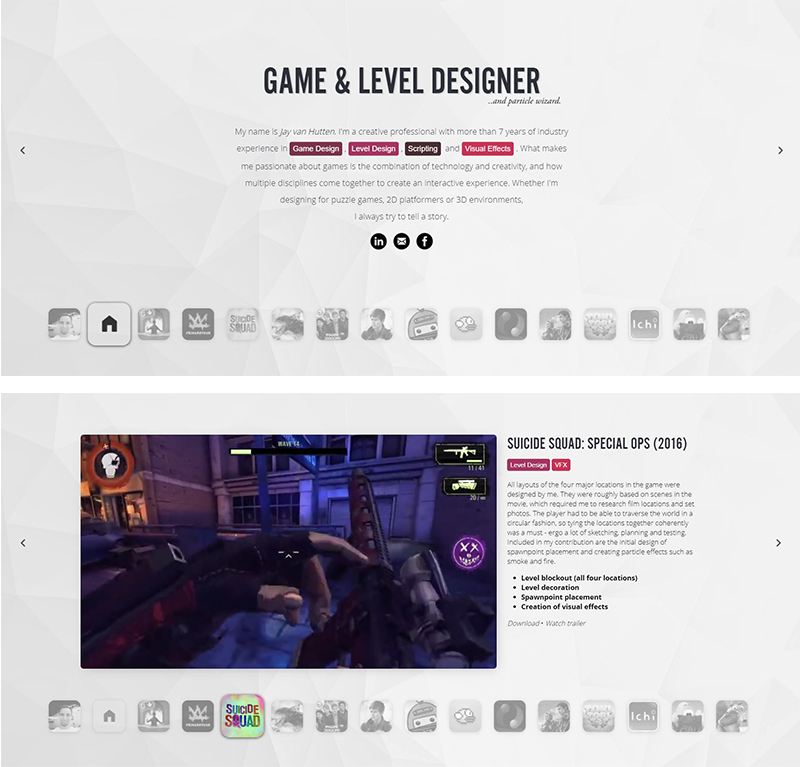
A counterexample to this point would be Sebastian Rangger’s portfolio. His approach is a lot more personal, navigation being organized around a vertical timeline. Projects are well showcased, and the original approach to navigation is completely in-tone with his experience.
And talking about projects…
3. You need meaningful projects
When I hire a new designer, I am not looking for a universal resource to flesh-out the details of my designs. What I am looking for is a meaningful addition to my teams. Someone unique, with their dreams, their talents, their strength, their design interests.
All of these things, I will try and get them from your portfolios, and this what they should showcase: your unicity as a designer.
This is another classic mistake I see in an enormous amount of portfolio: pages and pages of irrelevant projects, as if quantity was everything: Unity tutorials (please, no more “2D platformer 101″), Flappy Birds copies, 3D shooters prototypes (that usually contains no more than an asset store rigged character and brainless infinite enemies in a debug environment)…
Don’t get me wrong: these are terrific projects to learn the ropes of video game development, and I encourage everybody to start there! But these have nothing to do in a game designer portfolio.
In a portfolio, focus on the projects that show researches, expertise, and interest in game design. If you present me with a 2D platformer, I’ll scrutinize your navigation parameters and sense of control of the main character. A puzzle game? Difficulty metrics, puzzles complexity, and usability. A shooter? Signs and Feedback, shooting feel, and enemies’ AI. I want to understand what makes you a designer worth investing in, and I will judge that on the depth of your projects, and your design process.
Hugo Peters’ portfolio takes a very interesting approach. Compared to the previous example, that was very savvy of information, this one is extremely extensive in everything that Hugo did on each of his projects. This risks drowning visitors in content, but a very smart category collapsing prevents that. I have an overview of his work and can go dig by myself in the ones that pick my interest. “Aim assist with prioritization sorting”? Ah, exactly one of my concerns on my current project!
This Overview > Project > Feature approach works extremely well here.
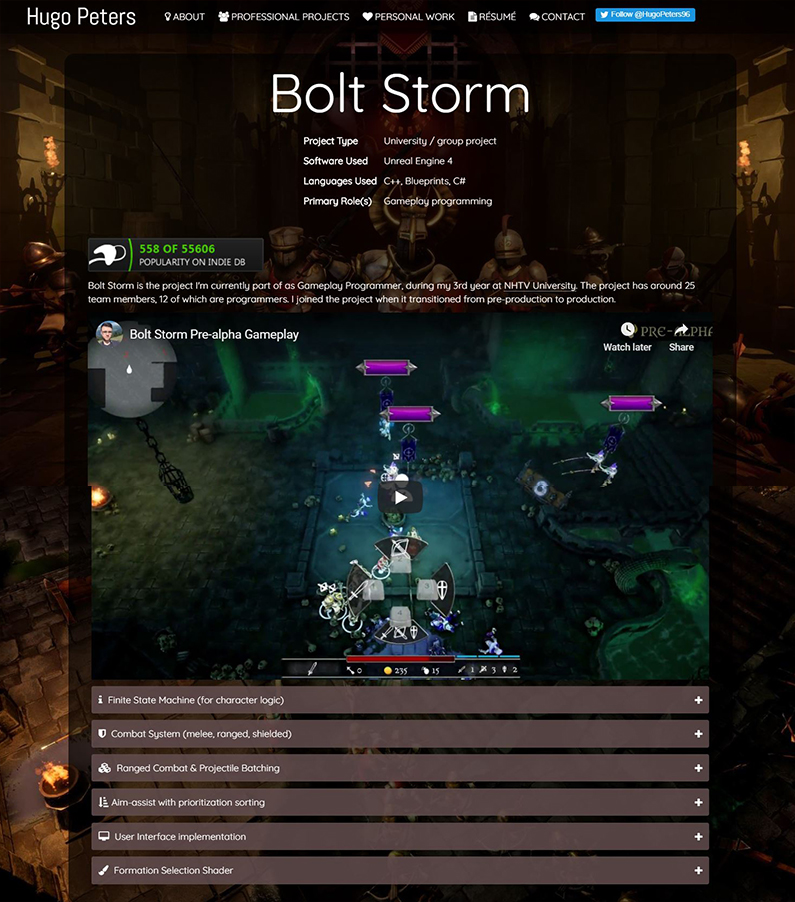
Now, you may feel that I am asking a lot from you, especially if you are trying to get into the industry. Not many applicants have awards-winning games to showcase. But there are other ways…
4. Portfolios aren’t only about video games
So many applicants, some with years of top experience, believe that slapping big games’ names on their portfolio will do the trick to prove that they are accomplished designers. The reality is very different. Let’s take my example: I was lead game designer on Assassin’s Creed Origin. Does it tell you anything about my worth as a designer? I may have been a terrible one! A tyrant with my team and the reason behind all the games’ current mistakes! There just isn’t any way to tell.
Instead, I could tell you about GDKeys, the articles I write, my personal games where I’m trying to push aspects of game design, the pen&paper RPGs I designed, the books I am writing… This would tell you a lot more about the kind of designer I am, what I believe in, what my thought process is.
How about you? What would show me what kind of designer you really are?
I need to browse fast through applications, but I will always find the time to read an article that would make me challenge my stances, play few games of a print-and-play card game, or play your game design experiments.
Bramha Dalvi’s portfolio is a great example of this point and an excellent example for industry newcomers. Bramha is pretty junior and doesn’t have many commercial projects to display in a portfolio. He then highlighted everything else he has done: some excellent game design articles he wrote, a print&play game ready to download, case studies… He circumventing his original issue by proving his worth differently.
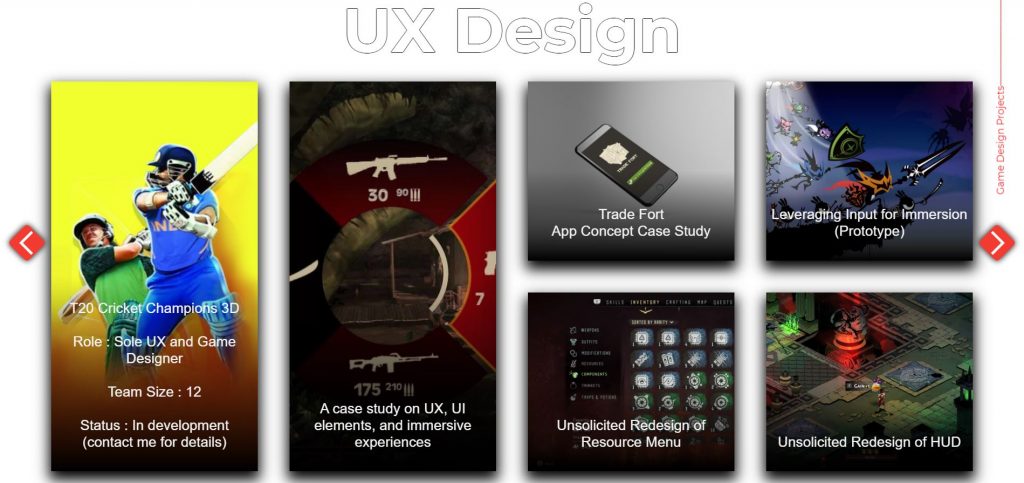
Which leads us to our fifth advice.
5. Remove frictions between the recruiter and your projects
Always remember that recruiters have an enormous amount of applications to go through. They will spend a minimal amount of time on yours if you don’t hook them fast.
We already discussed the risks of a badly designed web-portfolio, but this extends to everything. Do not ask me to download 2gb of data to play your demo, or to sign-up to a new platform to access your projects. This would be an instant turn-off.
Instead, some links to your Medium articles on game design? Direct links to browser HTML5 games and prototypes hosted on itch.io? A Youtube video explaining the design of your games, or the redesign of an existing one? These are instant wins. Frictionless and sure to get my attention.
Nathalie Jankie’s portfolio is another great example. Not only she went for a WordPress template making her projects instantly shine, but she also made sure to give direct access to all the necessary links: PDF to design document, embedded Youtube videos, direct download links for her playable games.
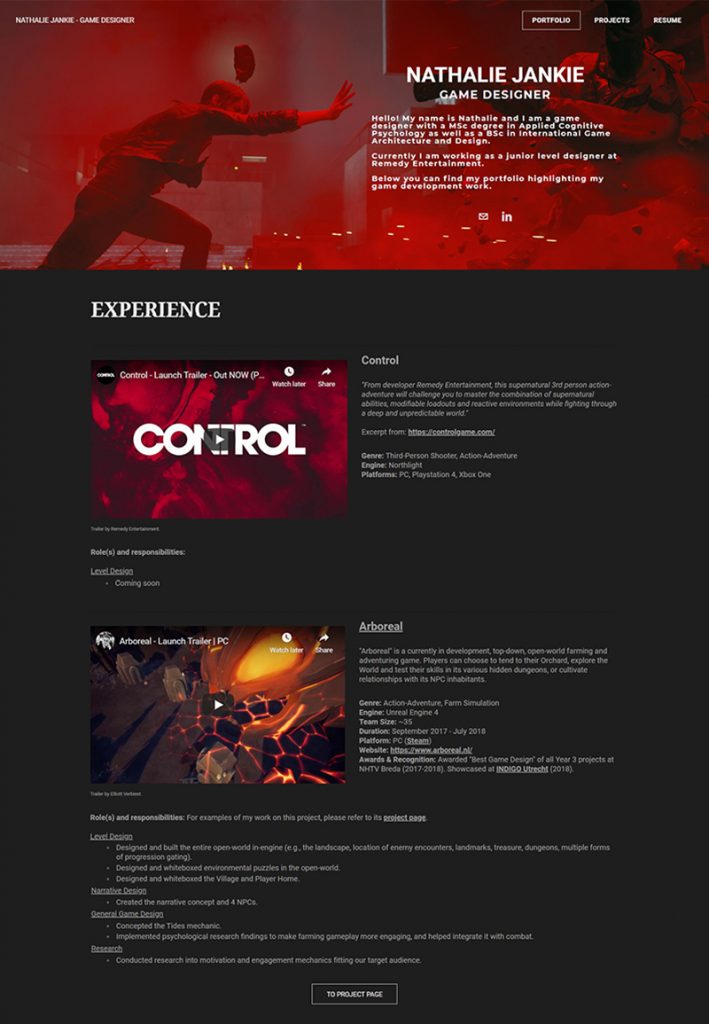
In comparison, my personal portfolio isn’t good enough on this point: it puts the emphasis on me more than on my projects, found at the bottom of the page.
As you can see, most of this article has been dedicated to portfolios. Once again, this is the most important piece of your application. Give it love, test its impact and usability with others, and make sure it shows to recruiters, as fast as possible, what you are made of.
Now, two other documents will probably be required from you in a classic game design application: a resume, and possibly a cover letter, and these are usually filled with the same mistakes.
6. Be honest with yourself in your resume
This advice is probably the most important one I can give you while building your resume. You probably have little experience, and pretending otherwise, inflating your resume, is only going to harm your application.
Almost every entry-position resume I end up evaluating is following this trend: a student, fresh out of design or programming school, stating mastery in a multitude of professional softwares, high proficiency in 3 engines or more, and significant experience in multiple side jobs (animation, rigging, coding, lighting, etc.).
This just isn’t possible, and pretending otherwise will make you look unrealistic or cocky and I for sure won’t try to filter the truth from the hopes.
Try and be really honest with yourself: you have talents, that is certain. You may have really dug the blueprint system of the Unreal Engine. You may have a particularly advanced level in Photoshop coming from artistic studies… Put these in front! Those are the ones that matter and that must reach a recruiter. Usually, these talents will mirror, and be supported by, your portfolio. Tell me your story! You are this raw diamond with a unique story and you need to convince recruiters to invest in you.
Also, while we are on the topic of resumes and over-promising: your resume MUST fit on a single page. You can’t possibly have enough experience to go over a one-pager. Even myself, after 10+ years in this industry, do not believe I deserve this second page.
I do not want to share personal resumes here, so instead, I’ll link here my own resume from 2 years ago. Feel free to criticize it.
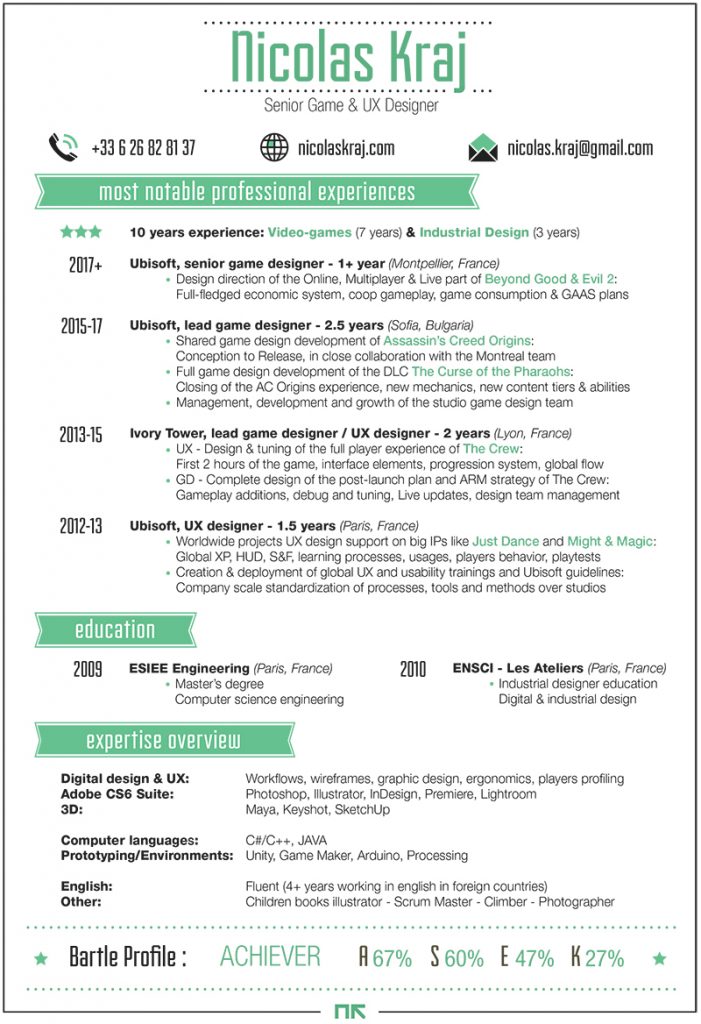
7. Build your narrative
This final advice, though particularly applying to your cover letter, should transpire through all your material.
As stated at the start of this article I, and most of the companies and recruiters I know, aren’t interest in molded templated designers. Game designers are at the start of the creation process, driving entire productions, and their impact will be felt through every aspect of a game. Your personal story is thus extremely important for us.
Usually, 95% of the cover letters I receive contain the same elements. It starts by mentioning you are passionate about video games: played all the games possible, 15 hours a week, for the past 10 years. This is meaningless for recruiters. Playing games and making games are 2 very different things and being good at one doesn’t mean you will be good at the other.
A cover letter will usually continue by mentioning that working in the industry is a dream of yours for a long time. This, again, isn’t giving anything to a potential recruiter. You must refrain from putting yourself in the role of the “eager player but by no mean designer”.
Instead, tell me your story. What are your achievements? What drove you to this application today? What are the steps you took through your life that shaped you as the designer you are today? Your narrative is key here: it needs to show logical, meaningful steps.
You may be a modder for years or moderating a video game community. Maybe you are a former architect, with a strong global vision, or a graphic designer with a developed sense of user-centric design. You may have participated in 20 Game Jams and are now ready to tackle something bigger?
This is what matters the most in your cover letter: how my teams and games will grow and benefit from your experience and past, how we will build the next steps of your narrative together, how inviting you for an interview would be the best decision I could take today.
As mentioned at the start of this article, most applications recruiters receive are badly prepared and are instantly discarded.
Following these tips will put you in the 10% top applications.
That’s an excellent start! But the last percents to climb are now on you: never stop learning, never stop making games, never stop questioning our medium and experimenting. It will pay off, not only for this job but through your entire career.
Do you want to get regular quality articles on Game Design and join an awesome community of devs and designers on our private Discord to discuss design, learn, and review each other’s games? Then consider supporting GDKeys.

This is actually really helpfull, things like actual references to portfolios and how they’re structured and in-depth analysis in how to make the most of past experiences and showcasing them in a short and precise way to don’t waste anybody’s time. Thanks a lot for this articles, they really make a difference in how to tackle certain things that i was doing wrong in the past. Found this site today but i’ve been reading the articles non-stop!
Thanks a lot Matias! Very appreciated, and glad this site is helping you!
A clear and highly informative article. Thank you so much. Loving your work on here.
I wonder if you intend to do one regarding interviews? or are interviews within the games industry so varied and specific to studio/role that you feel this would be too broad a subject? (I appreciate that perhaps they just require the same skills as other job interview types rather than being industry specific)
Ps. Found you through Reddit.
Hey! Thanks so much for checking this place!
I’ve been wondering if I should write one on interviews… For the reason you pointed here: it’s very, very different from a company/interviewer to another.
I could write one based on my own approach while conducting one. But this would of course be biased 🙂
It’s on my list: I will get to write it at some point 🙂